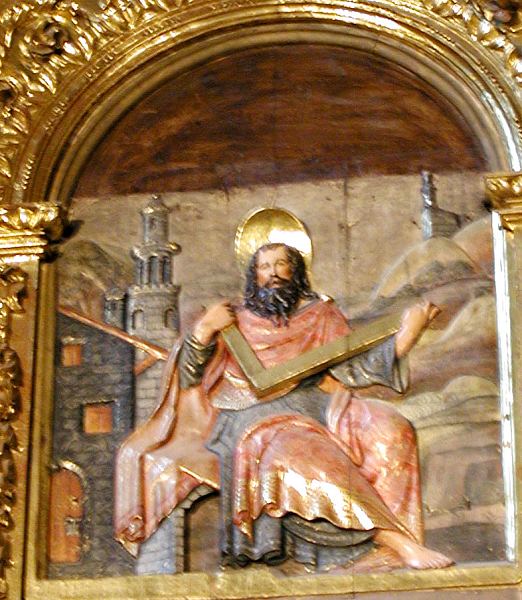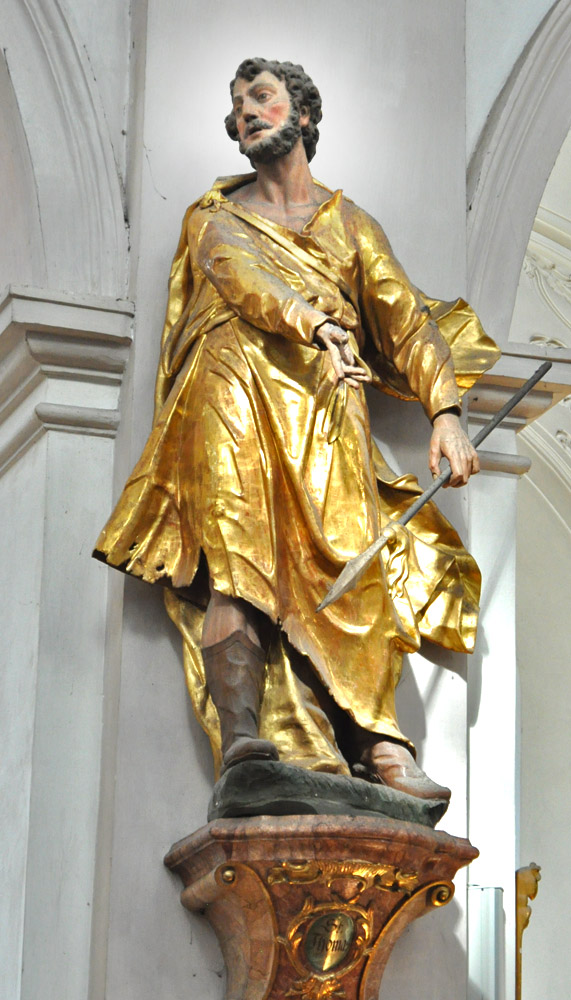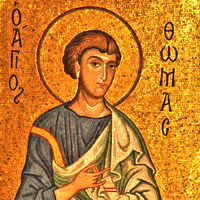The reason for the spear comes in the next part of his legend. In a vita of the 8th or 9th century Thomas proceeds to another region of India where the king is not so accepting of his religon. He puts the saint through a long series of torments and finally has his executioners spear him to death. In an earlier vita the saint rejoices that he is dying by the same instrument that once dispatched his Savior.1
The Golden Legend has a different account of Thomas's martyrdom. Enraged that the saint has destroyed an idol in his temple, an Indian priest runs him through with a sword, as we see in this stained glass in Regensburg Cathedral. I have found only one portrait in which he holds a sword instead of a spear.
Like the first two pictures at right, most medieval images give Thomas a full beard and a full head of hair. But mosaics influenced by Orthodox iconography make him a beardless youth, as in the third picture at right and this mosaic in St. Mark's, Venice. A much-portrayed episode in Thomas's life is narrated in John 20:24-29. Thomas had been absent when Jesus first appeared to the Apostles after the Resurrection, and he doubted their word that he was risen: "Except I shall see in his hands the print of the nails, and put my finger into the place of the nails, and put my hand into his side, I will not believe." When Jesus appeared again he invited Thomas to do just that. Putting his hand into the wound in Jesus' side, Thomas realized the truth and said, "My Lord and my God!" An early mosaic of this event keeps Jesus almost fully clothed in a tunic and pallium and does not show the actual touching. A 14th-century fresco at Pomposa shows the touch but remains somewhat stylized in presenting Jesus' body. By the 17th century caution is gone: Bonzi's painting adopts Caravaggio's device of having Jesus guide Thomas's hand into the wound.
THE VIRGIN MARY'S BELT
The Golden Legend's account of the Assumption briefly mentions an old story that St. Jerome had dismissed as apocryphal centuries before. Supposedly Thomas was absent at the Assumption and would not believe that Mary had been taken up into Heaven bodily. But then "the girdle with which her body was girt came to him from the air, which he received, and thereby he understood that she was assumpt into heaven." Apocryphal or not, the story was very popular in late medieval art (examples from Il Pastura and Gozzoli).
Prepared in 2015 by Richard Stracke, Emeritus Professor of English, Augusta University. Revised 2018-04-03.

A 17th-century Spanish relief of St. Thomas with the carpenter's square as his attribute.(See description page)

An 18th-century German statue of St. Thomas with a spear as his attribute (see the description page)

An Orthodox image of St. Thomas in Sicily (See description page)
MORE IMAGES
- 14th century (?): A fresco in Salamanca's Old Cathedral puts a "doubting Thomas" panel beside one of Jesus telling Mary Magdalene, "do not touch me"!
- 1516-18: A panel in Oviedo Cathedral's main retable.
- Circa 1520: A Doubting Thomas Majolica plate.
- 2nd half of the 16th century: A panel in a Spanish altarpiece with St. Thomas receiving the belt.
- Mid-18th century: This statue of St. Thomas has him holding a mattock.
- Undated: Painting of St. Thomas with a spear in an Austrian church.
DATES
- Feast day: originally December 21 in the Roman Calendar, now July 3 in that calendar and several others
NAMES
- Also called "Didymus," "the twin"
BIOGRAPHY
- Golden Legend #5 (Life of St. Thomas): html or pdf.
- Golden Legend #119 (The Assumption): html or pdf.
- Acts of the Holy Apostle Thomas.
- The Consummation of Thomas the Apostle.
- Roman Breviary: 1908 English translation, I, 673; 1632 Latin version, 787-88.
ALSO SEE
NOTE
1 Pseudo-Abdias, 451-52; Consummation, ¶7. According to the Consummation's translator the manuscript on which his work is based is from the 11th century but the text itself is "properly a portion" of the Acts of the Holy Apostle Thomas, the original form of which was known in the second century.